I’ve had my hands full with the new baby, but that doesn’t mean I’m not still eyeing a lot of board games on Kickstarter as always. With Gen Con coming up, there have been a slew of projects launching—so many that with some of the prototype copies I’ve been sent I’ve only been able to play once or twice so far. (Plus, hey, I’ve been playing some of my long-awaited Kickstarter rewards…)
With that in mind, here are six board game projects that I’ve actually gotten to try out (ordered by time left in the campaign): Incredibrawl, Chaos & Alchemy, The Agents, Magnum Opus, Click! Clack! Lumberjack!, and King’s Forge.
Of course, caveat emptor.
1. Incredibrawl
We’ll start with Incredibrawl, a funny game that’s got about a week left and just hit its funding goal recently. The core mechanic is like rock-paper-scissors: you each pick character cards, and compare powers—Physical beats Natural, Natural beats Energy, Energy beats Physical. Same power? Compare numbers instead. You square off in pairs, with the winners from the first round facing off against each other to see who wins the whole brawl. The winner gets a Glory point, and first to 10 Glory wins.

What Incredibrawl adds is a bunch of crazy powers. Each character has a power; some are activated as soon as the card is revealed and some only if you win the whole brawl. (Or, in the case of the Kitten, when you lose.) The powers let you do things like steal Glory from other players, keep them from drawing cards, or even swapping out their fighters with their discard pile. There are also Power-Up cards, which can be played to change the outcome of a fight or other crazy effects. Finally, there are the Location cards, which can give bonuses to certain characters (like Sci-Fi characters, or characters with Physical power).
It’s not a deeply strategic game, but it can be pretty fun, particularly for younger kids. I love the illustrations, particularly the way the characters show up on the Power-Up cards acting out those abilities. You can get a print-and-play for $10, or the whole game for $25. ($30 gives you access to some exclusives, but they’ve rejiggered the rewards so that all copies come with the stretch goals rather than just the $30-and-up levels.)
Risk assessment: This Kickstarter is by V3G (Vision 3 Games), a spin-off from Vision3, an interactive creative agency. It’s their first tabletop game, but it’s a company that is used to hitting deadlines and handling large projects. We’ll see how close they get to their estimated February 2014 delivery.
2. Chaos & Alchemy
Chaos & Alchemy is another quick-playing game with dice and cards. Michael Iachini of Clay Crucible games had released the game on his own in a limited print run with black-and-white illustrations. He’s now partnering with Game Salute to fund a full-color version.
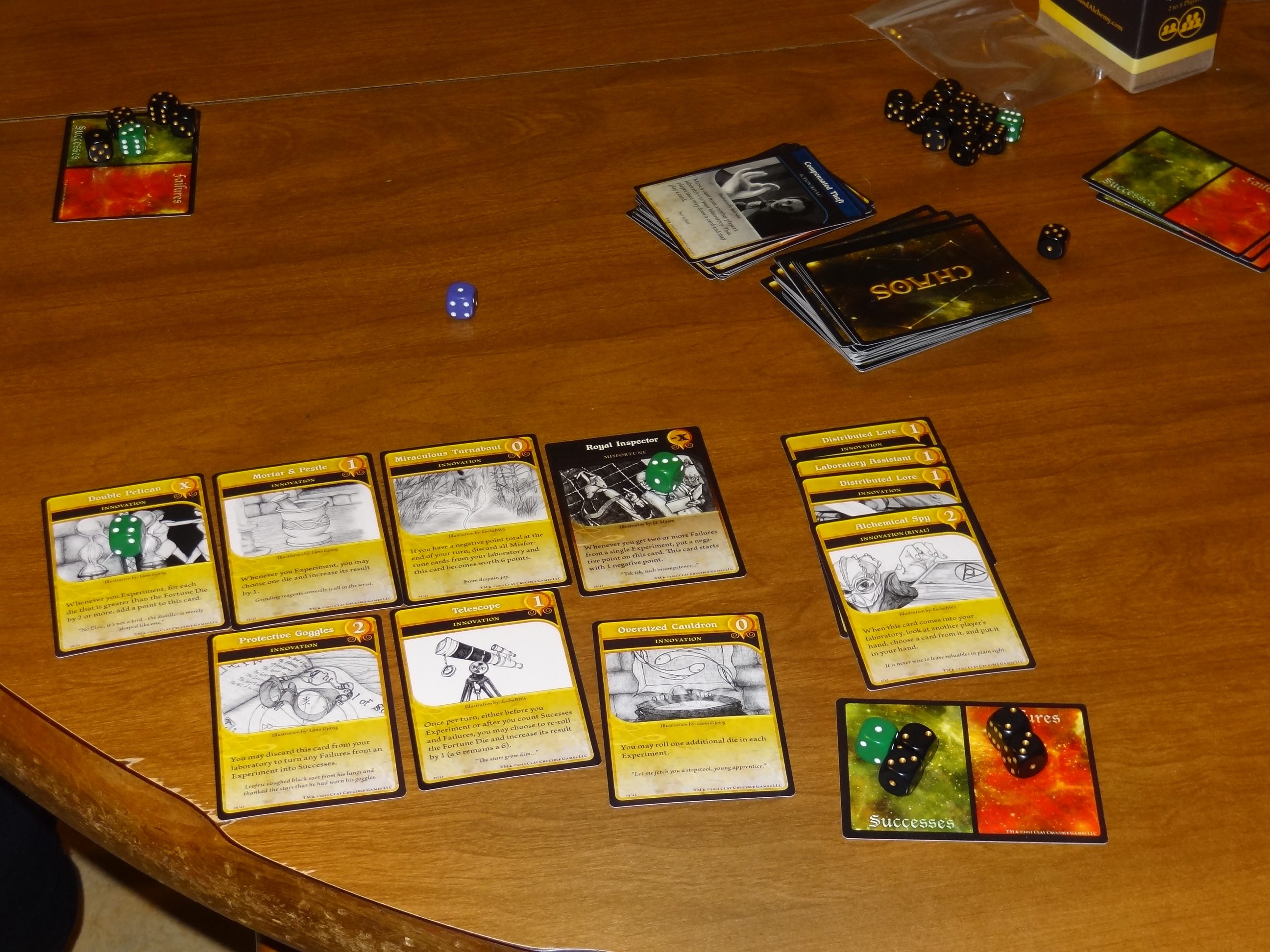
Here’s the gist: you’re all alchemists, trying to transmute lead into gold—in this case, by getting your laboratory to be worth at least 10 points. On each turn, you roll your Experiment dice and compare them to the purple Fortune die in the center of the table. Each die that meets or exceeds the Fortune die is a success, and all others are failures. (You also get one automatic success per turn.) Each success lets you draw or play a card, and each failure costs you a card. If you roll doubles, that’s “Chaos” and you’ll actually re-roll the Fortune die, which will then affect the next player. (Normally, the Fortune die stays the same from player to player.)
Cards can be played to your laboratory to increase your score—some have one-time effects when they’re played, and others grant you ongoing abilities … as long as you have the card. But of course, alchemists being sneaky backstabbers, you’ll have plenty of opportunities to steal things from other laboratories or otherwise wreak havoc on your competitors.
Chaos & Alchemy does live up to its name: it is chaotic and fortunes can change dramatically in a single turn. However, there is some method to the madness, and you can try to balance bad luck with careful planning, up to a point. I found the game pretty easy to teach, though it is one of those games that requires a bit of reading the first time through because all of the cards have a good deal of text on them. Usually, when I played it, the game seemed to end before we expected it to—that could be good or bad depending on your perspective. I do like the theme and the card effects tend to reflect that; however, the end goal seems more arbitrary thematically—reaching 10 points doesn’t automatically turn lead into gold.
Risk assessment: Game Salute has run a lot of Kickstarter campaigns, and they definitely know the business of getting games printed and distributed, although they have run into the usual hiccups getting rewards delivered by the estimated dates in the past—some of that may be due to the sheer number of campaigns they handle. They do offer a money-back guarantee, so you can get a refund of your pledge (if not the wait).
3. The Agents
If you like spies and double-crossing, take a look at The Agents. Each player is in charge of two teams of agents—though “in charge” may be a little misleading, because everyone is a double agent in this game.
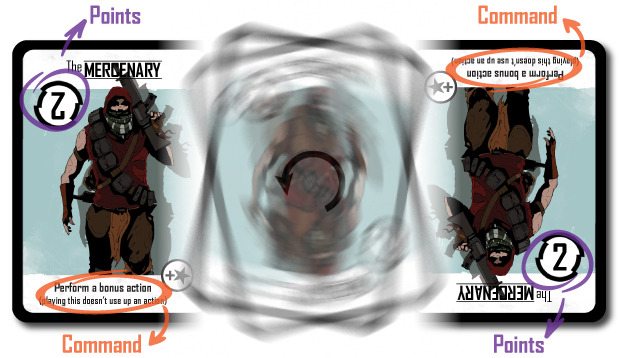
Key to the game are the “double-edged” cards, which have a command and a point value facing opposite directions. When you play a card, you can decide on its orientation—you’ll get the points or the ability, but your opponent gets the other. This makes for some tough decisions, because you’ll need those points to win, but the abilities are very valuable, too. Agents will swap places with each other, kill each other off, and so on. To make it harder, some cards have half an arrow for the points—you have to have both halves matching in order to score points from these agents.
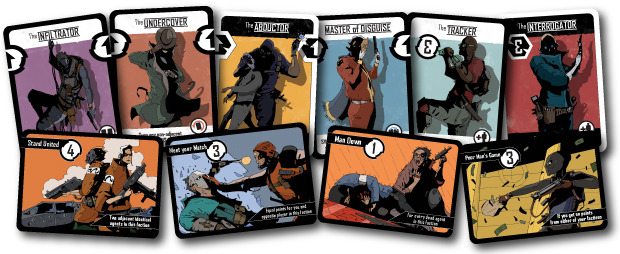
There are also mission cards—you can assign missions to your teams, which get you points if that particular team fulfills the requirements. This can be a good way to rack up points, but your opponents will do their best to rearrange things to prevent mission success. Finally, to add one more wrinkle, you only get more missions and agents by spending points—so you’ll have to decide wisely when to spend them and when to hoard them.
The stylized artwork by Danny Morison is great, and reminds me a bit of B.P.R.D. With the theme, though, I would recommend previewing the cards before playing with younger kids, as there are of course lots of weapons of all sorts and an array of disreputable characters.
RIsk assessment: This is the first game design from Saar Shai; most of the artwork seems to be done (though the artwork for the custom cards will be created after the campaign ends), and the game is entirely cards—even the victory points are cards—so the production should be pretty straightforward. There are a couple of threads on BoardGameGeek (here and here) that mention that Shai was also part of the Ringbow project which has been delayed and there are folks upset about it. However, the two projects do seem to be quite different in scope, and the Ringbow campaign was handled by Shai’s business partner Efrat Barit. I won’t get into too much detail here—Shai has responded to the threads himself, so it’s up to you to decide what you think. The Agents has currently raised over $130,000 (on a $6,000 goal), so there are a lot of supporters. If you’re worried, you could always wait and see if it hits stores later.
4. Magnum Opus
So it turns out that transmuting lead into gold is just for beginner alchemists. What you really want is to create the Philosopher’s Stone. Welcome to Magnum Opus, a game that takes deck-building and turns it into a tool of discovery and experimentation.
I’ll start with the bad news first: this game takes a lot of setup. That image you see above is the starting set up—basically you set out all the different types of cards, each in their own pile, and then the 4×4 grid that forms the discovery matrix.
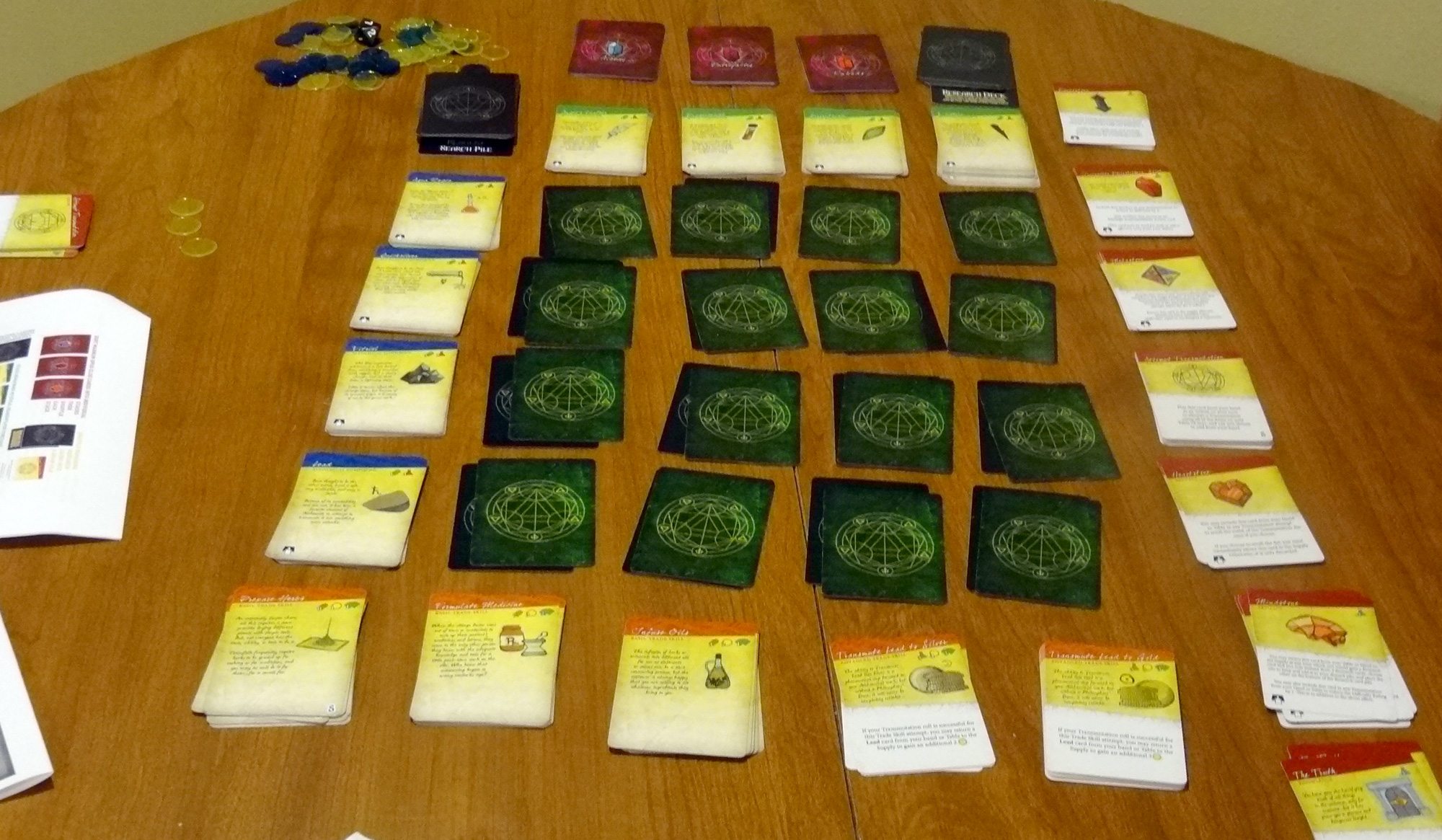
Also, the game can be a little overwhelming at first—for the “Experimentation” phase of your turn, there are six different actions to choose from … and that’s just one of the four phases of your turn. However, once you actually get a sense of what the game is about, it starts to make sense, and each turn doesn’t actually take very long at all.
The heart of Magnum Opus is that discovery matrix: there are 16 random discovery cards, bordered by the eight types of reagents (4 blue alchemical compounds and 4 green mystical components). When you successfully combine two reagents, you get to flip over the card at the intersection of those two cards. Hidden among them are the three Magnum Opus clues which you’ll need to formulate the Philosopher’s Stone.
On each turn, you can play tradeskills which will earn you money or let you draw more cards. Then you can prepare your table—you can put any number of reagents on your table to store them from turn to turn, but you can only attempt a transmutation if your table is clear of extraneous reagents, and you can only add or remove two table cards per turn. Finally, you use the Experimentation phase to collect more reagents, learn tradeskills, or (as the name implies) perform an experiment by transmuting two ingredients.
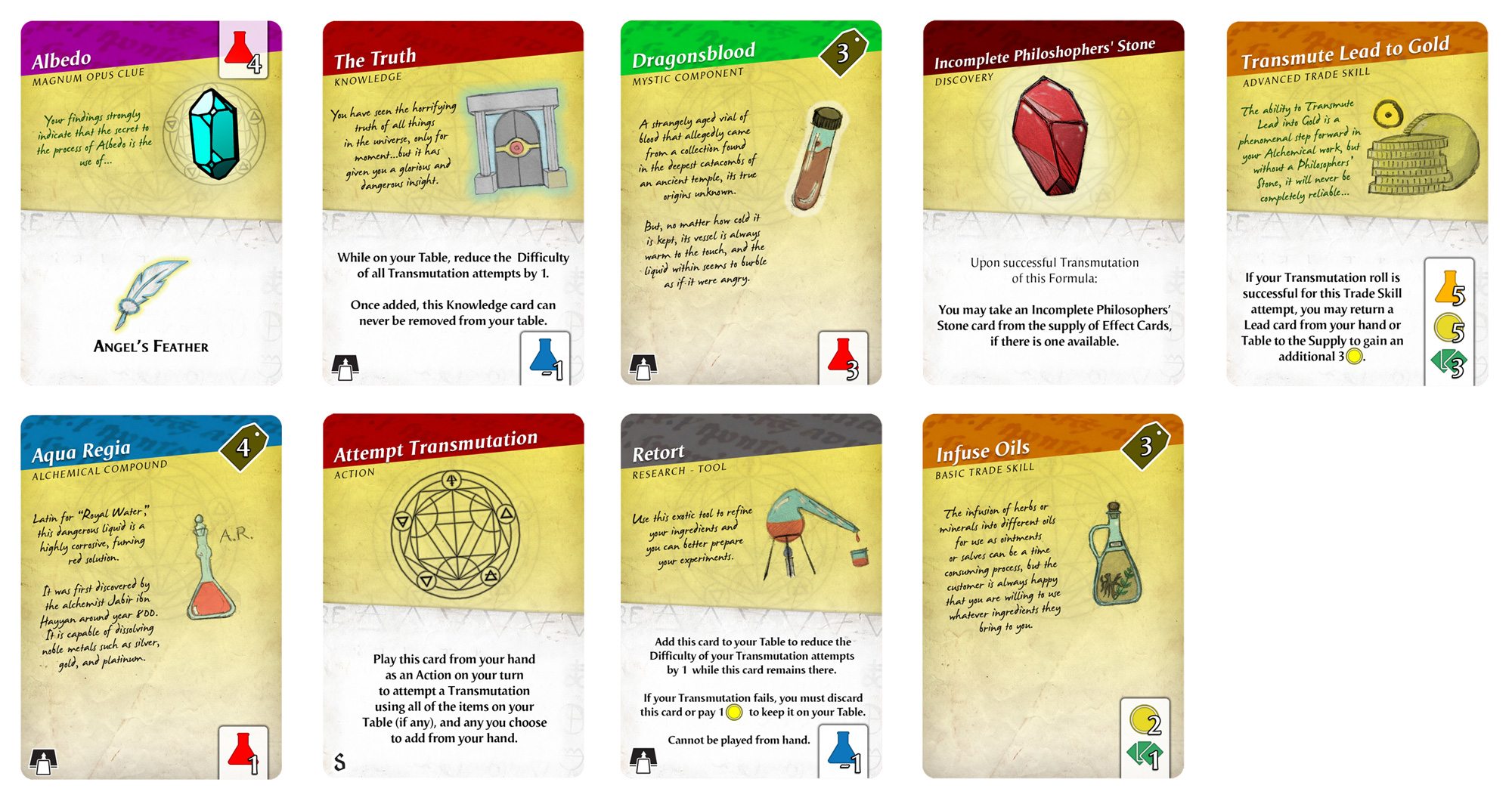
Each time you attempt a transmutation, you have to roll the eight-sided die, and the difficulty depends on the two reagents you’re combining (as well as any tools or knowledge you possess). One fun mechanic is that you gain experience when you fail an experiment—and those experience points can then be turned in to add to future die rolls. It’s a great way to simulate learning from your mistakes.
The ultimate goal of the game is to find your three clues, and then successfully perform a transmutation with those three reagents. Each person’s three clues will be different, but the method of obtaining the clues is similar in each case.
At first I was put off by the setup because it looked overly complicated, but having played Magnum Opus a couple of times, I can say that I really enjoy it and look forward to playing it again. I like the goal of finding the clues—something specific you’re trying to obtain—rather than just a set number of points you’re trying to reach for no apparent reason. The randomized discovery matrix also makes each game different, as you never know which reagents will lead to more valuable discoveries.
There’s also a good deal of humor in the game. One of my favorites is “transmute gold to lead.” Oops! You made a mistake—but then all the players have to discard coins and put lead (the least valuable reagent) into their discard piles.
One complaint about the cards, however, is that there is a lot of text on them (some flavor text, some game effect text) but the important numbers are tiny and hard to see from across the table. Also, the font used for the card names may be thematically appropriate, but can also be hard to read. Once you’ve played the game a few times I think you’ll get used to the illustrations, but I think it would make the game a lot more approachable if things could be made more legible. I suppose there’s still time for them to make changes, but I don’t know if they will.
Overall, though, if you like deck-building games with a goal other than “score the most points,” Magnum Opus scratches that itch.
Risk assessment: Magnum Opus is also being handled by Game Salute, and published by Clever Mojo Games. Both have a proven track record, and Clever Mojo has had some great success with their previous games. Again, Game Salute has their money-back guarantee on this one.
5. Click! Clack! Lumberjack! (Tok Tok Woodman 2.0)
I’ll just come right out and say it: this one is a must-have. Click! Clack! Lumberjack! is a slight redesign of Tok Tok Woodman, which Mayday Games funded back in May of 2011. I didn’t get in on it then, but ended up buying it as an extra reward for one of their later Kickstarter projects, and it’s a favorite around my house.
Here’s what it is: you get a plastic tree that’s made up of several core segments, each with four pieces of “bark” that attach to them, and a big plastic axe. Assemble the tree, and then take turns whacking at the tree with the axe (two whacks per turn). For each piece of bark you knock off, you get a point. For each core segment you knock off, you lose five points. The game ends when there’s no more bark on the tree.

Because the bark only slides off when it’s hanging far enough over the edge, you end up having to create extremely precarious towers, and it can be totally nerve-wracking. In a good way.
I’ve played this with my kids and with hardcore strategy gamers, and it’s always a blast—and it’s hard to play just once. You can go up to 7 players (or more, really, although too many and chances are the tree will have toppled by the time it’s your turn), so it’s a great party game, and it doesn’t take long.
Here’s what’s new this time around: First, a better box. The original came in a pretty large box, even though there’s not a lot to put in it. The new packaging is much more compact, so you can take it with you. There are additional variants in the rules, including some grub stickers that you can put on the bark to make certain pieces give special effects. The price is also lower this time around—particularly if you get the “flatpack” shipping option in which they send you the new box flattened and you pop it together yourself. Oh, and the name is different for some reason.
If you own the original, it’s probably not enough to make it worth buying it again (except, of course, for all those people you need holiday gifts for) but if you missed it the first time, it’s a pile of fun for as little as $17 (in the US).
Risk assessment: As Mayday Games says in their “Risks and challenges” section, they’ve run 13 projects in the past two years, and most of them have been fully delivered. They’ve run into some delays with some projects (particularly Bootleggers) but I know that in some cases they’ve even had games printed and ready to go by the time the Kickstarter campaign ended. Since this one is a re-make and the plastic manufacturing is the same as the last time, I’m fairly confident in their ability to deliver this one on time.
6. King’s Forge
King’s Forge is all about crafting items—you start off with five iron (dice), and you have to utilize those to get wood, gems, and magic, so you can create things like armor and axes and fancy toys. It’s a game with piles of dice, and it plays in about 45 minutes.
Each round has two parts: Gather and Craft. First you use the Gather cards to get more dice—you’ll use the dice you have to go get more, or trade them in for more valuable resources. Depending on the Gather card you use, you might get your old dice back, or they might get used up and returned to the supply. If you’re desperate for a particular resource, you can always go to the Black Market, where you can get what you want but prices are steep.
After everyone’s done gathering dice, you get to roll your remaining dice and try to craft various items on the king’s wish list. You need the right number of dice, and you have to roll at least the numbers shown on the card. However, going for the bare minimum isn’t a great idea, because other players can try to steal the card by making a better version. You made a table with a 3 wood and 4 wood? Well, my table is made out of a 5 wood and 6 wood, so the king likes mine better. The goal is to be the first to craft four items—in the case of a tie, the person with the most valuable (and difficult to craft) item is the winner.

I’ve played this a couple of times, and it’s pretty fun. The various abilities that let you add to die rolls, gain extra dice, etc., give a lot of variety, and because the Gather cards are randomized each round, you have to figure out the best strategy with the dice you have on hand. However, the game itself isn’t too complicated to learn, and it feels pretty quick once you’ve figured out how to use the Gather cards and the Black Market.
Risk assessment: As with Magnum Opus, King’s Forge is a Game Salute/Clever Mojo project, so you’ve got a good pedigree and the money-back guarantee if you don’t like it.

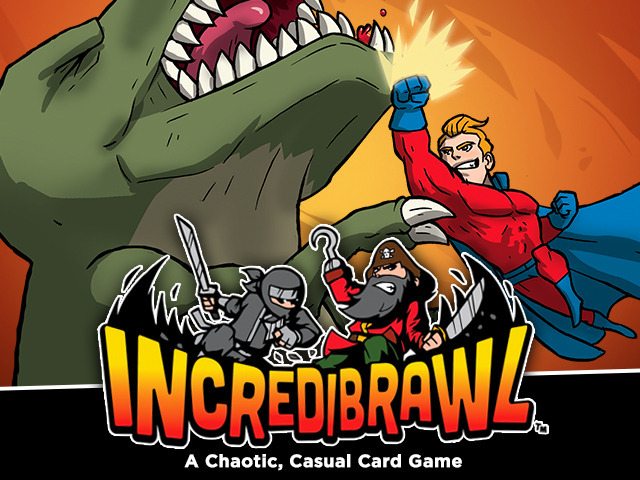
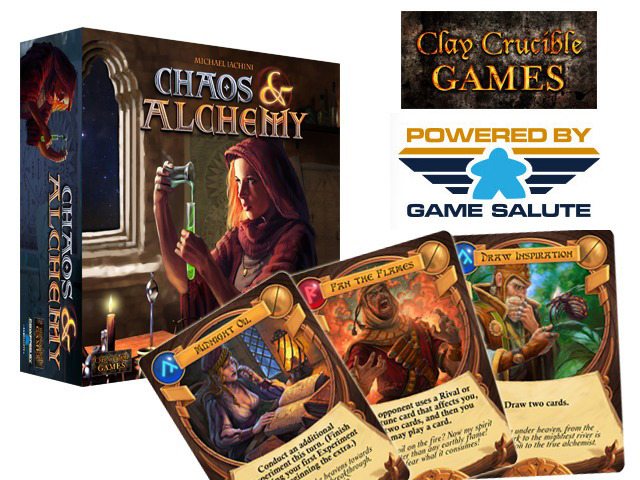
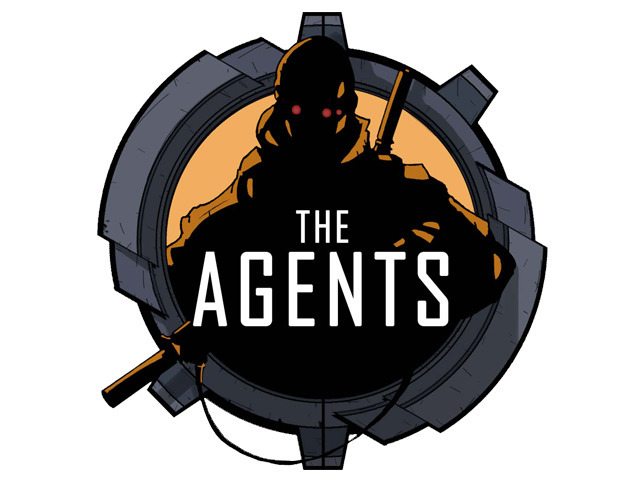
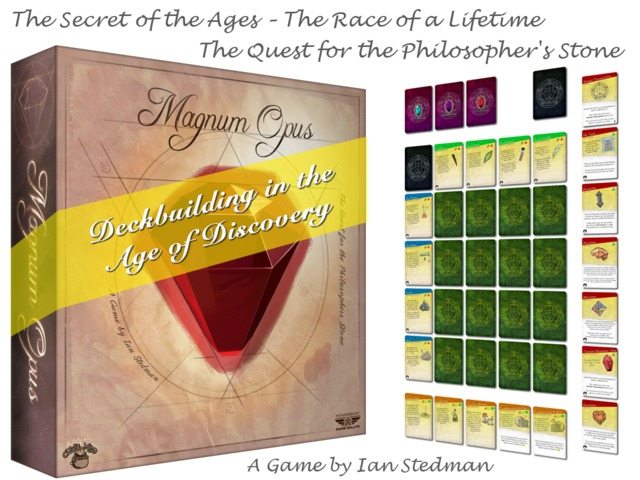


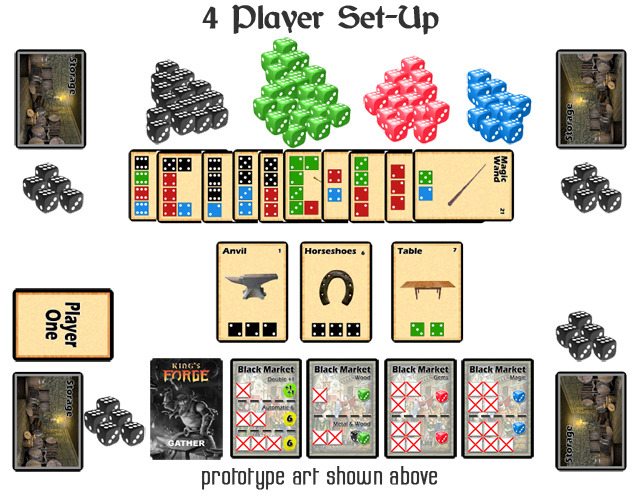



This is also amazing:
http://www.kickstarter.com/projects/laurob/a-duel-betwixt-us/?ref=kicktraq